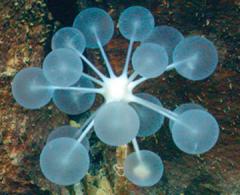
This Article From Issue
November-December 2010
Volume 98, Number 6
Page 469
DOI: 10.1511/2010.87.469
This roundup summarizes some notable recent items about scientific research, selected from news reports compiled in Sigma Xi’s free electronic newsletters.
Spiders Versus Plants
Wolf spiders and carnivorous sundew plants have the same taste in bugs. That makes them the first example of animals and plants that compete for food, say ecologists who studied the species in Florida swamplands. There, the sticky leaves of the carnivorous pink sundew plant (Drosera capillaris) and the funnel-shaped webs of the wolf spider Sosippus floridanus caught similar proportions of flies, springtails and ants. Where sundews were extensive, spiders compensated by building bigger webs; in the lab, the presence of a competing wolf spider (Rabidosa rabida) halved the number of flowers a sundew could produce.
Jennings, D. E., et al. Evidence for competition between carnivorous plants and spiders. Proceedings of the Royal Society B 277:3001–3008 (October 7)
The Key to Sound Sleep
Bustling brainwaves may act like earplugs for heavy sleepers, blocking disruptive noises from the environment. Sleep researchers brought 12 healthy adults into their cozy lab, and measured their brainwaves during one peaceful night and two nights fraught with abrasive sounds—from slamming doors to roaring jet engines. People who could sleep through the most racket also produced the most spindles, brainwaves generated in the thalamus during sleep. The thalamus regulates sensory input to the cerebral cortex, so spindles may represent a direct cause of oblivious deep sleep. But even if they’re only a marker, spindles could help guide treatments for the sleep-deprived.
Dang-Vu, T. T., et al. Spontaneous brain rhythms predict sleep stability in the face of noise. Current Biology 20:R626–R627 (August 10)
Bacteria Can Smell
There’s no doubt that we humans can smell bacteria. Now a study of Bacillus licheniformis suggests that bacteria can smell each other too. Researchers noticed that undernourished bacteria formed thick pink biofilms, instead of colorless clusters, when they lived adjacent to well-nourished microbes. But each culture was physically isolated from the next, so only a volatile odor could have tipped them off about their neighbors. The messenger was ammonia, microbiologists concluded after a series of experiments with cells in various nutrient media. Ammonia is a byproduct of bacterial metabolism, and cells that can get a whiff of their neighbors may be better able to find resources or brace themselves for competition.
Nijland, R., and J. G. Burgess. Bacterial olfaction. Biotechnology Journal (published online August 18)
How Many Asteroids?
A single large meteorite that struck the Gulf of Mexico usually gets credit for annihilating the dinosaurs. But it may not have been alone. Geologists recently found a smaller crater in Ukraine and collected a 2,000-foot-deep sediment core there. Pollen and fern spores reveal that the local flora were just beginning to recover from the Ukrainian impact when another disaster struck. Evidence of that second disturbance matches the global signature of the Yucatan impact, which must have occurred just a few thousand years after the Ukrainian one. The chances of two such strikes in succession are minute, suggesting that both were part of an asteroid shower, perhaps generated by a collision of celestial bodies.
Jolley, D., et al. Two large meteorite impacts at the Cretaceous-Paleogene boundary. Geology 38:835–838 (September)
A Canine Mind Bender
When humans honed some dog breeds for their puggy faces, they also reorganized the canines’ brains. Studying 11 recently euthanized pound dogs and 2 living pets, researchers recorded skull dimensions and brain images from several breeds. Even controlling for bodyweight and brain size, they found that brains of short-skulled dogs such as mastiffs were tilted forward, and their olfactory lobes were on the brain’s underside instead of on its front. That relocation may preserve frontal lobe volume and cognitive function—but the researchers hypothesize that it also jeopardizes the sense of smell. Just another reason not to take the Shih Tzu on a fox hunt.
Roberts, T., et al. Human induced rotation and reorganization of the brain of domestic dogs. PLoS ONE 5:e11946 (July 26)
Ancient Antibiotics
The discovery of penicillin in 1928 launched a revolution in modern medicine. But people in North Africa may have already made antibiotics some 1,500 years earlier. Decades ago, anthropologists noticed that bones of Nubian mummies fluoresced under black light, just like bones of modern humans who take the antibiotic tetracycline. The drug binds to calcium and is incorporated into bones. To confirm that the mummies contained tetracycline and not another fluorescent compound, researchers extracted antibiotic from the bones and compared it to modern samples of the drug. They were chemically identical. Anthropologists suspect that the Nubians purposely brewed the medicine in fermented beer-like beverages.
Nelson, M. L., et al. Mass spectroscopic characterization of tetracycline in the skeletal remains of an ancient population from Sudanese Nubia. American Jouranl of Physical Anthropology 148:151–154 (September)
An Overflowing Sink
In a potentially grim adjustment to the atmospheric balance sheet, land plants are soaking up less carbon than they used to. Until now, global vegetation kept pace with increasing CO2 emissions because warming promoted plant growth and carbon uptake; from 1982 through 1999, plant productivity increased by 6 percent. Now droughts have begun to counterbalance the growth-inducing warmth. A new set of satellite images indicate that worldwide plant productivity dropped by 1 percent from 2000 through 2009, the hottest decade on record. If the trend continues, more CO2 could be left in the atmosphere to drive warming, and crop plants may produce less abundantly.
Zhao, M., et al. Drought-induced reduction in global terrestrial net primary production from 2000 through 2009. Science 329: 940–943. (August 20)

American Scientist Comments and Discussion
To discuss our articles or comment on them, please share them and tag American Scientist on social media platforms. Here are links to our profiles on Twitter, Facebook, and LinkedIn.
If we re-share your post, we will moderate comments/discussion following our comments policy.